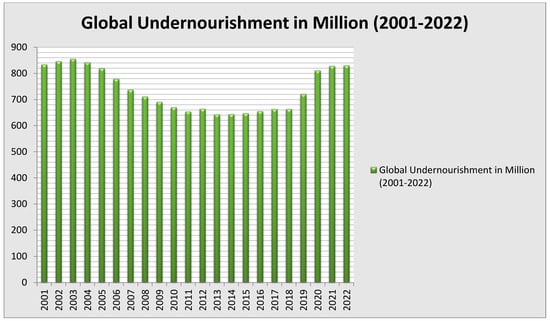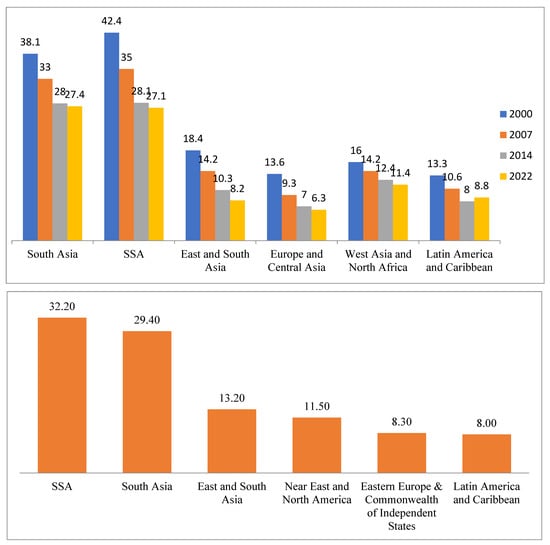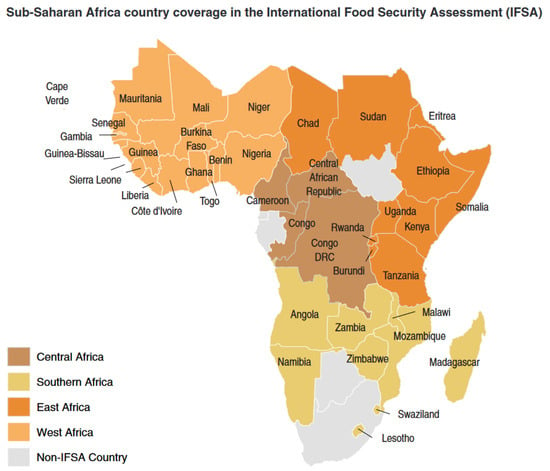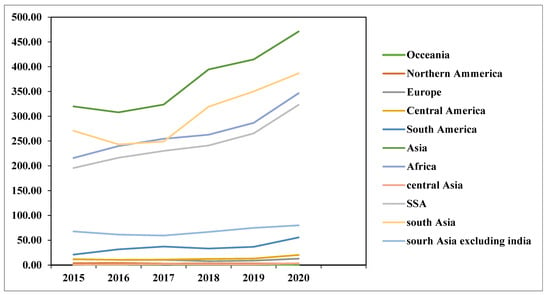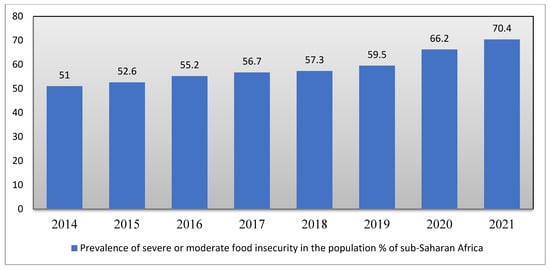All around the world, inequalities persist in the complex web of social, economic, and ecological factors that mediate food security outcomes at different human and institutional scales. There have been rapid and continuous improvements in agricultural productivity and better food security in many regions of the world due to an expansion in crop area, irrigation, and supportive policy and institutional initiatives. However, in Sub-Saharan Africa, the situation is inverted. Statistics show that food insecurity has risen since 2015 in Sub-Saharan African countries, and the situation has worsened owing to the Ukraine conflict and the ongoing implications of the COVID-19 threat.
1. An Overview of the Concept of Food Security
Since the 1974 World Food Conference, at which concerns of hunger, famine, and the food crisis were explored at length, the complex idea of food security has garnered continuous attention and economic relevance [
22,
23,
24]. Although it has evolved, the concept of food security remains the same: “a situation that exists when all people, at all times, have physical, social, and economic access to sufficient, safe, and nutritious food that meets their dietary needs and food preferences for an active, healthy life.” This multifaceted definition is based on four pillars: Availability (or adequate food supply), affordability (or low prices), stability (no food shortages or seasonal swings), and utilization [
25,
26].
Webb and Sheeran [
27] claimed that individuals go hungry not because food is not readily available in the market, but because they cannot afford to buy it. Therefore, it is essential to differentiate between food supply and food demand. Availability is a term commonly used to describe the state of food supplies, and thanks to developments in agricultural output, availability has increased over the previous few decades. The unequal distribution of food occurs not only within households, but the term “access” is also usually employed to highlight the issue of demand [
28]. The global food price issue could reverse the decades of progress in alleviating hunger and malnutrition and putting an end to extreme poverty.
1.1. The Trend of the Global Food Insecurity Situation since 2000
In 2017, about 1.9 billion individuals lacked consistent access to appropriate nutrition [
29]. While most of those affected by food insecurity reside in the low-income countries in Sub-Saharan Africa and South Asia, this issue impacts individuals worldwide [
30]. All nations must be able to acquire and maintain nutrient-dense diets that are diverse. Achieving food security and eliminating hunger are two 2030 Sustainable Development Goals of the United Nations. Despite the world’s nations concentrated efforts to alleviate global hunger, the number of undernourished people grew in 2015, following a decline from the 2003 to 2014 (
Figure 1). According to the Food and Agriculture Organization (FAO), up to the year 2020, over 825 million people will have gone hungry, and roughly 2 billion will have been moderately or severely food insecure [
31]. Due to the additional 60 million victims of hunger since 2014, the number of undernourished people is projected to reach 840 million by 2030 [
30], which is a significant rise over the present estimated figure of 380 million [
30] (
Figure 1). Every day, a colossal 830 million people worldwide suffer from hunger (
Figure 1). As a direct result of COVID-19 and the ongoing conflict in the Ukraine, the number of people experiencing acute food insecurity rose dramatically from 135 million in 2019 to 345 million in 2022 [
32]. Even with the recovery of the global economy, [
33] anticipated that eight percent of the world’s population, or 670 million people, would still be hungry in 2030. This is comparable to 2015 when the 2030 Agenda for Sustainable Development established a goal date for this decade to abolish world hunger, food insecurity, and malnutrition. According to the World Food Program, 50 million people in 45 countries are at risk of extreme hunger [
32]. Historically, droughts and other natural disasters have been the leading causes of food scarcity [
34].
Figure 1. Global undernourishment in millions. Source: World Bank Database, 2022.
1.2. Sub-Saharan Africa and the Global Hunger Index
The International Food Policy Research Institute (IFPRI) developed a scale to assess food insecurity called the Global Hunger Index (GHI), which takes into account three indicators: stunting, malnutrition, and infant mortality [
29]. On a scale from 0 (no hunger) to 100 (the worst case), this is measured with the following criteria. Child wasting: the number of children under five who are too thin for their height; this is a sign of severe malnutrition. Child stunting: the number of children under five who are stunted, which means they are short for their age because they do not get enough food. Anemia: the percentage of the population with anemia, which shows how many people are not getting enough calories (partially reflecting the serious interaction of inadequate nutrition and unhealthy environments).
South Asia and Africa, south of the Sahara, have the highest levels of hunger in the world according to the GHI values, 27.4 and 27.1, respectively, in the year 2022 (
Figure 2), and both regions are experiencing a stagnation in the fight against hunger. In South Asia and SSA, where the scores were 28.0 and 28.1 in 2014, progress in eliminating hunger has virtually stagnated in comparison to the progress recorded from the year 2000 to 2014 (
Figure 2). In terms of the development required to meet the second Sustainable Development Goal of “Zero Hunger” by 2030, Africa, south of the Sahara, is gravely behind the agenda [
35].
2. The Sub-Saharan African Food Security Situation
Africa is home to at least one-third of the world’s undernourished population and is the only continent where agricultural productivity per capita has been falling for the past 30 years [
36]. Africa’s population is expected to expand from its estimated 1.2 billion in 2020 to over 1.8 billion by 2050; more than half of the continent’s inhabitants are under 20 [
37]. The agricultural sector employs around 60% of the labor force, produces approximately 22% of the GDP, and accounts for more than 10% of export revenues. The SSA countries coverage in the international food security assessment in this study is presented in
Figure 3.
According to research conducted by Harvard University Professor Calestous Juma, Africa could achieve food self-sufficiency if it stopped depending on food imports [
9]. Farsund, Daugbjerg, and Langhelle [
38] concluded that Africa’s land resource could quickly produce an additional 100 million tons of grain-equivalent a year if it were intensively farmed. Africa has significant untapped potential, as seen by the region’s relatively low yields compared to other regions with similar agro–ecological zones like South Asia. Utuk and Daniel [
39] reported that about 800 million hectares of land in SSA is ideal for rain-fed agriculture. This suggests that Africa possesses a considerable amount of arable land that, if improved, may ensure the region’s long-term food security. However, despite Africa’s vast agricultural potential, it has struggled to embrace modern agricultural techniques fully. If Africa does not adopt modern farming techniques, it will waste the rich resources already in the continent and be forced to rely on expensive imports [
40] (Juma, 2015). It is projected that by 2025, the annual cost of importing food will increase from its current level of USD 35 billion to USD 110 billion.
Figure 3. Map of the Sub-Saharan African countries. Source: Adapted from [
41]. Accessed on 10th August 2022.
Currently, 346 million people in Africa are undernourished (
Figure 4). With the percentage of people experiencing food insecurity expected to drop from 40.5 percent in 2020 to 24.4 percent in 2030, SSA is predicted to experience the slowest improvement in food security [
42]. The World Bank reported in 2021 that 7.2 million people in East Africa are at risk of hunger, while 26.5 million experience severe food insecurity. Acute malnutrition affects at least 12.8 million children in this area.
More than 50 million people in Africa require emergency food aid annually, making it the continent that now gets the most food aid. Sixty percent of WFP’s efforts are focused on Africa [
43]. Twenty-seven million people in West Africa are experiencing severe hunger, the highest number in ten years [
44]. Allegedly, food crises have increased across most of West Africa, including Burkina Faso, Niger, Chad, Mali, and Nigeria [
44]. Approximately 27 million more individuals have required emergency food aid from 2015–2022 [
45].
Due to an unprecedented drought and the continuous conflict in East Africa, particularly in Somalia, Kenya, and Ethiopia, an estimated 81.6 million IDPs, refugees are residing in rural and urban areas within and outside these countries [
46]. Southern Ethiopia, eastern and northern Kenya, and southern and central Somalia are all experiencing worsening drought conditions, which have led to a lack of water and pasture, the death of livestock, below-average harvests (65% in Somalia and 70% in Kenya’s marginal agricultural areas), a surge in the price of cereal and other staple foods, and a decrease in the purchasing power of the residents [
47].
According to [
49], since 2015, there has been an increase in food insecurity across Africa. In 2015, there were 52.3 million people who experienced severe to moderate food insecurity; by 2017 that number rose to 56.7 (
Figure 5). In 2020, around 66.2% of people (
Figure 5) had moderate to severe food insecurity; of this number, 30% had severe food insecurity and almost 37% had moderate food insecurity [
50]. Wang, Andrée, Chamorro, and Spencer [
51], estimated that 704 million people living south of the Sahara experienced food insecurity in 2021.
In industrialized nations, undernourishment is less than 2.5%, but in most of Africa, the situation is dire [
52]. In 2019,
Figure 6 depicts the percentage of people in several Sub-Saharan nations experiencing moderate or severe food insecurity. As shown by the figure, more than half of the population in most SSA nations suffers from moderate or severe food insecurity.
This entry is adapted from the peer-reviewed paper 10.3390/ijerph192214836
